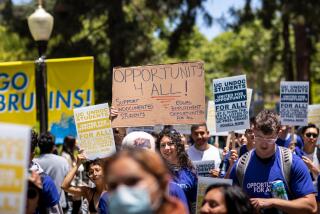Brown follows centrist course with earned income tax credit
- Share via
SACRAMENTO — If you were the governor with extra bucks to burn, would you help the working poor? Or help the aged and disabled poor who are unable to work?
Another choice: Provide healthcare for immigrants in the country illegally? Or help poor kids get dental care.
Gov. Jerry Brown had these and many such options to choose from last week in revising his $169-billion budget proposal for the next fiscal year.
In the above cases, he opted to spend money on the working poor and the immigrants here illegally, but stiff the impoverished aged and disabled and children with toothaches.
It isn’t easy being California’s Democratic governor when you’re casting yourself as a tightwad bent on preserving budget discipline even as tax money overflows the treasury.
“I don’t want to get caught in the jaws of the persistent fiscal instability of the state of California,” Brown told reporters. “One thing we know is when governors leave town with big deficits, they’re more scorned than praised.”
Brown heard some scorn in 1983 after he left his gubernatorial successor, Republican George Deukmejian, with a tub of red ink. And his father, Democrat Pat Brown, heard it louder in 1967 when he left Republican Ronald Reagan with a badly bleeding budget.
Jerry Brown is famous for his canoeing skills — paddling a little on the left, then on the right and setting a middle course.
One of Brown’s major budget proposals is the epitome of centrist canoeing. It enjoys bipartisan support. Democrats like it because the working poor get cash. Republicans like it because it’s actually a tax cut and doesn’t grow government.
It was a clever Brown move to get ahead of a Legislature already heading in that direction.
The governor proposed California’s first earned income tax credit for the lowest paid workers. He’d spend $380 million on roughly 2 million people.
Here’s how it would work: A single worker earning under $6,580 annually — or a family of three taking in less than $13,870 — would get a refundable tax credit, meaning a check from Sacramento. It would complement a similar federal program.
The average household benefit would be $460; the maximum $2,600. Half the states have something similar.
Brown recalled that the federal earned income tax credit was enacted 40 years ago when Republican Gerald Ford was president. Brown had just become governor.
“Given the tremendous growth in income on the part of higher-income people,” Brown said, “I thought it would be reasonable to establish this program…. I have always liked the [tax credit] because it doesn’t have any particular bureaucracy or complexity. It’s just a straight deliverance of funding to people who are working very hard and are earning very little.”
Democratic legislators have proposed a more generous tax credit. A reporter asked the governor whether his proposal was “just a token.”
“Well, for certain families making low income — probably part-time workers — they can get as much as $2,000, $800, $600,” Brown replied. “That’s a lot of money when you’re at the bottom. So it’s something…. It’s not trivial.”
Yes, a good plan, particularly given the state’s growing surplus and the gargantuan gap between rich and poor.
Brown often is rapped by fellow Democrats for not helping the poor. “I’ve heard that,” he acknowledged, describing the criticism as “endless.”
In his latest budget proposal, however, Brown set aside money to provide healthcare for immigrants here illegally but protected from deportation by presidential executive order, if the White House decree survives a court suit. It’s a $200-million annual state program.
But Brown rejected pleas to spend $200 million a year on fixing a state dental care program for the poor. It’s called Denti-Cal. Problem is, reimbursement rates for dentists haven’t been raised in 15 years. Plus, there was a 10% cut two years ago.
That means increasing numbers of dentists are refusing to treat these patients, most of them children. The state auditor found that nearly 60% of kids on Denti-Cal are unable to find treatment, the 12th worst record of any state.
But at least the children have a dental lobby pushing for them.
California’s 1.3 million impoverished aged, blind and disabled, however, arguably are the most powerless in Sacramento. Unlike labor unions and professional groups, they can’t donate to political campaigns. There’s no pay-to-play money.
These folks live entirely off federal and state subsistence programs (SSI/SSP). Singles get a below-poverty-level $889 per month; couples less than $1,500. They’re eligible for Medi-Cal healthcare, but not for food stamps.
“There are extreme cases of hunger,” says Frank Tamborello, director of Hunger Action L.A., an activist group. “I know of one 74-year-old woman who goes through garbage cans.”
The state has been doling out only the federally required minimum since the recession. These most vulnerable of all the poor have lost 10% of their meager purchasing power in recent years.
“People are pleading,” says Assemblywoman Cheryl Brown (D-San Bernardino), who’s trying to pass legislation to boost grants. “Many have no caregivers, no children or they’ve moved away.
“I talked to one man who told me, ‘I might be homeless, but I’m a veteran and a senior citizen and I want to look good. Want to smell good. I don’t think it’s right.’”
Brown paddles along, banging the aged and disabled on his starboard.
Twitter: @LATimesSkelton
More to Read
Sign up for Essential California
The most important California stories and recommendations in your inbox every morning.
You may occasionally receive promotional content from the Los Angeles Times.











